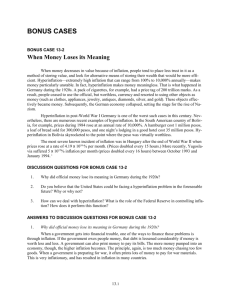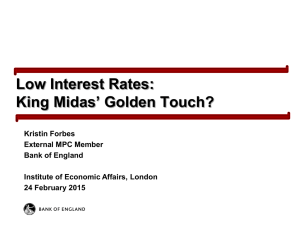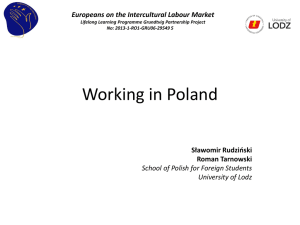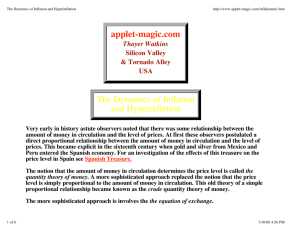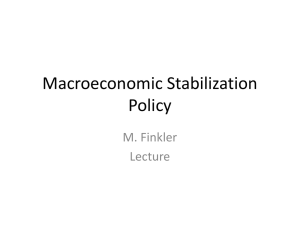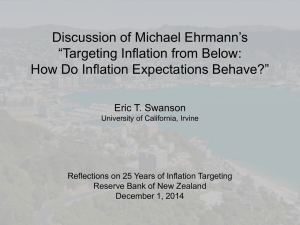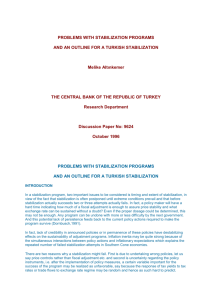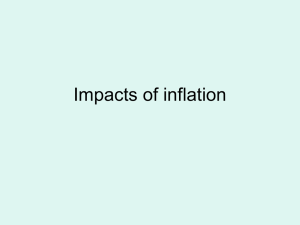Post WWI Development
advertisement
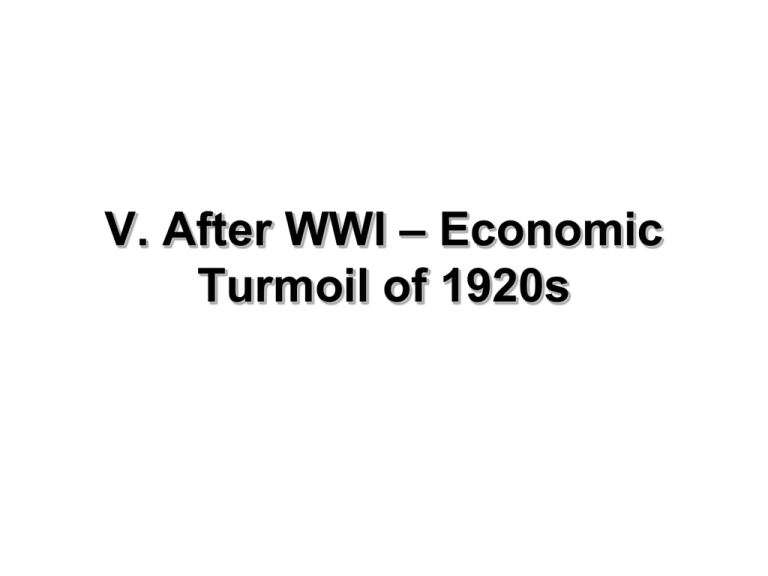
V. After WWI – Economic Turmoil of 1920s V.1 Economic consequences of Versailles peace World War I • Massive military conflict, end of established system • Political consequences: – new political map of Europe – political weakening of the main European powers (both winners and losers), strengthening of the USA – emergence of Bolshevism in Russia – “end of the world” – an attempt to establish a new international order: 14 points of President Wilson Economic consequences of WWI • Immense human and material losses, dramatic fall of standard of living • European countries abandoned gold standard (not the USA) and pre-war international financial order ceased to exist – end of the system of fixed exchange rates – no free flows of gold and capital in general • Excessive indebtedness of European countries (again both winners and losers) • End of social order in its pre-war form Economic aspects of Versailles treaty • Old debts appended by new debts – war reparation and the discussion on maximum limit Germany can pay – compensation payments – difficult (impossible) timetable to repay • Alsace-Lorraine back to France, Saarland internationalized • Opposition on the side of the winners – John Maynard Keynes, The Economic Consequences of the Peace Implications • Fragmentation of the global economic system – Germany – condemned to economic misery – Soviet Union – self-imposed isolation – European economies – increase of protectionism, end of free trade and free flows of capital • Monetary and financial matters – Britain (and sterling) was not able to play the role of leading economy, much stronger USA were not prepared/willing Perils • Economic instability – additional factors: new structure of costs and increasing price and wage rigidity • Radicalization of population in Germany (Bolshevism, Nazism) • Lack of international coordination of economic policies seeds for Great Depression and WWII V.2 Hyperinflations of early 1920s Layman’s evidence • 1913 - value of all currency in Germany was 6 billion marks • October 1923 – the same amount was enough to buy one kilogram of bread • Months later – the price of same bread was 428 billion mark • Comparable situation in 4 countries: Austria, Hungary, Poland and Germany – Not in Czechoslovakia! V.2.1 The data Summary: selected facts (Source: Cagan – see Literature) Austria Hungary Poland Germany 1. Start Oct. 1921 Mar. 1923 Jan. 1923 Aug. 1922 2. End Aug. 1922 Feb. 1924 3. No. month Jan. 1924 Nov. 1923 11 10 11 16 4. PT/P0 69.9 44.0 699.0 1.02x1010 5. MT/M0 19.3 17.0 395.0 7.32x109 6. (4)/(5) 3.62 2.59 1.77 1.40 7. Avg.gr.P 47.1 46.0 81.4 322.0 8. Avg.gr. M % per month 30.9 32.7 72.2 314.0 9. (8)/(7) 1.52 1.41 1.13 1.03 % per month Comment to summary • Definition of hyperinflation – start: the month where inflation > 50% – end: months before month when inflation dropped bellow 50% and stayed there for a year • Clear trends in extraordinary growth of prices and of amount of nominal money, but – extreme volatility in particular months – huge differences in magnitudes across the 4 countries – numerical characteristics become closer only when we compare averages (row 9) V.2.2 Sources and origins Broad origins • War damages, post-war turmoil, unrealistic reparations payments • Structural problems – Austria, Hungary: small countries, that inherited structure of a large empire – Germany: political and moral decay, unpopular new democracy (Weimar Republic) – Poland: extremely stripped of the resources during the war, peace restored only in 1920 • All countries: – extreme poverty (need for social payments) – inefficient state enterprises, providing vital functions (need for subsidies) – except Poland, obligation to pay reparation Budgets: deficits • All countries: substantial budget deficits, because of • Expenditures – see above • Income – time lag between the moment of tax being levied and time when collected: loss of value due to inflation – Inefficient collection, in Germany even to some extent a Government policy, as a protest against reparation (and later, French occupation of Ruhr) Budgets: financing • Governments – not able to pursue quick structural changes – social priorities: to ensure at least basic social and administrative order and services – and - maybe - underestimation of inflationary threat – consequently, given the reparation, expenditures given • Inability to borrow • The only way – monetization of the debt Debt monetization • Weak monetary institutions, no independent central banks • Borrowing from monetary institutions, that created new money – short-term government obligations (T-bills), purchased by state monetary institutions – un-backed by gold or foreign exchange reserves – huge discounting of new notes: e.g. on Austrian notes, interest equal 6-9% when inflation was of order of 104, in Hungary even private notes with low interest were discounted by Central Bank – excessive demand, need to ration the purchase of state notes • This created large increase of high-powered money, total money supply further inflated by money multiplier Hyperinflations • In all countries this process reached a momentum (in different periods), when inflationary spiral started • Basic causality: budget deficits money growth inflation – consistence with quantity theory of money – role of inflationary expectations • Other accompanying features – depreciations of the currencies – flight from domestic currency, regulations trying to prevent it, but • inefficient, black market • part of money supply held in foreign currencies Impact on economy and policy • Monetary economy less and less efficient • Price signals ceased to be useful – higher variation of relative prices • Much larger and faster changes in inflation • Expectations that the state will finance debt further on • Real economy – in the short run - running (a) relatively “well”, (b) independently on hyperinflation – consistency with classical model predictions V.2.3 Stabilizations and lessons Basic steps Common for all four countries • Credible commitment of central bank that it will not monetize debt any more – radical change in people’s expectations! • Fiscal reform, reduction of budget deficit – stabilizing tax system – reform on the expenditure side (end of subsidies, laying-off excessive state bureaucracy, etc.) • Central Banks legally forbidden to lend to Governments Specific steps (1) More country specific steps: • Loans: – Austria (League of Nations), Poland only in 1927, Hungary placed (issued) the loan abroad, secured by state salt and tobacco monopolies, no loan for Germany • Reconsideration of reparations: all except Poland, crucial for Germany (Dawes plan) • Currency reform: Poland and Germany in the moment of stabilization, Hungary slightly later, Austria substantially later – but just change of numeraire Specific steps (2) • After sheer depreciations, countries stabilized their ExR and were able to maintain it, but thanks to – drastic devaluations – massive interventions – large nominal interest (in first months 1020%) • In different countries differently, but in all cases the strategy was to return to gold standard Other issues (1) Real economy • There was a slow-down of output and increase of unemployment as a consequence of stabilization, but – shortly, followed by period of economic growth (till Great Depression), Poland back to smaller crisis in 1927 – unemployment increase much milder than expected (in Germany more difficult) • Still acceptable consistency with classical model Other issues (2) • Increase of money supply even after the price stabilizations, contradiction to QTM, but – money issued after stabilization were state liabilities, back by gold, foreign loans and – mainly – by the renewed state ability to collect taxes • Consequently – the new money was not inflationary • Return from foreign currencies into new domestic ones Lessons • Essential stabilization steps: simultaneous (a) creation of independent central bank, that stopped unsecured lending to the state, (b) change of fiscal policies, (c) change in inflationary expectations, (d) stabilization and defense of ExR • Government could borrow only with private sector and debt was ultimately backed by its ability to collect taxes efficiently • The main source of hyperinflation: growth of currency that was backed by government bills, unsecured by future state incomes • This created expectations that further fueled the inflation spiral, unless being broken by newly, generally trusted central bank’s policy • Earlier attempts to stabilize that failed (e.g. Germany): unless accompanied by fiscal reform, doomed to fail V.3 Return to the gold standard Second period of gold standard • 1925-1931, most countries re-adopted gold standard • During 1924 – stabilization of exchange rates even in countries that suffered hyperinflations, but, namely between sterling and dollar – positive strong correlation between relative prices (both in UK and USA) and exchange rate ₤/$ – April 1925: Britain decided to return to gold standard at pre-war parity Churchill’s policy mistake • In 1925, Winston Churchill – UK Chancellor of the Exchequer • Under new conditions – sterling overvalued – after the war, British prices increased faster than those of trading partners, return to pre-war parity = real appreciation – consequence: loss of international competitiveness • Keynes: The Economic Consequences of Mr. Churchill Real growth 1925-1930 Weakness of 2nd gold standard • Overvalued sterling • Adjustment mechanism worked badly • Rigid prices and wages • Much more complex political and economic environment • More than one financial center Literature to Ch. V After WWI economic order: • Keynes, John M. The Economic Consequences of the Peace. London, Macmillan, 1920. Hyperinflations: • Textbooks by Blanchard (pp.447-452) or Mankiw (pp.180-186). • Sargent, Thomas J., The End of Four Big Inflations, in: Hall, Robert, ed., Inflation. Chicago: University Press, 1983. • Dornbush, Rudiger, Fisher, Stanley, Stopping Hyperinflations: Past and Present, Weltwirtschaftliches Archiv 122 (1986), pp.1-47. • Cagan, Phillip, The Monetary Dynamics of Hyperinflation, in Milton Friedman (ed.), Studies in the Quantity Theory of Money, Chicago (1956, pp. 23 – 117. Return to Gold Standard: • Textbook by Blanchard (pp.405-6). • Keynes, John M., The Economic Consequences of Mr. Churchill. 1925 (in: Collected Writings).
